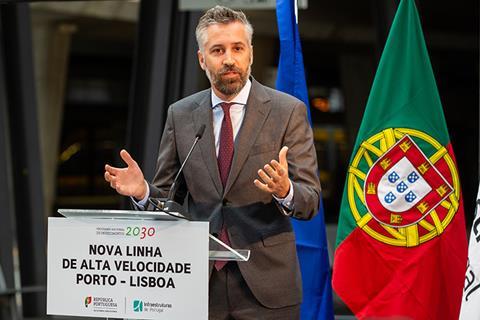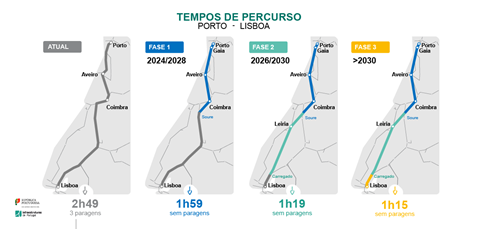
PORTUGAL: Plans to launch the development of a €4·5bn Lisboa – Porto high speed line as part of the PNI 2030 national investment plan have been announced by Prime Minister António Costa.
Speaking at the announcement at Porto Campanhã station on September 28, Minister of Housing & Infrastructure Pedro Nuno Santos said the project would be another step in a ‘rail revolution’ to develop the national network.
The high speed line to promote modal shift from motorways and aviation by reducing journey times between the country’s two main cities as well as to other destinations, and by decongesting Portugal’s main rail corridor.
At present, 730 trains per day run over sections of the 336 km Lisboa – Porto main line, representing 44% of all trains in Portugal and 92% of freight movements. There are 25 through passenger trains a day between the two cities, and the new line would enable an increase to 77.
Three phases

Development of the double track broad gauge line connected with the conventional network at Aveiro, Coimbra and Leiria is to be managed by national rail and road infrastructure manager Infraestruturas de Portugal.
The project would be divided into three phases.
The first would cover the 143 km between Porto and Soure, which has been prioritised as it is the most congested section of the existing route.
This is expected to cost €2·95bn, of which €1bn would come from EU sources. Tenders are to be called in H1 2023, with work to begin in 2024 for completion in 2028 when Porto – Lisboa journey times would be reduced to 1 h 59 min.
The first phase would be divided into two lots, with the 71 km between Porto and Aveiro (Oiã) estimated to cost €1·65bn and the 72 km between Aveiro and Soure put at €1·3bn.
The line would serve Porto Campanhã, Vila Nova de Gaia through a new station in Santo Ovídio, Aveiro and Coimbra-B, with existing stations being adapted for the new line. A road and rail bridge would be built between Porto and Gaia.
The second phase between Soure and Carregado near Lisboa has an estimated cost of €1·5bn, with construction expected to start in 2026 for completion at the end of 2030. This would reduce the non-stop journey time between Porto and Lisboa to 1 h 19 min.
The Carregado – Lisboa section of the existing main line would also be quadrupled between Castanheira do Ribatejo and Alverca.
The third phase of the high speed line would be developed between Carregado and Lisbon after 2030, reducing the Porto – Lisboa journey time to 1 h 15 min.
North of Porto, a new high speed section is also envisaged between Braga and Valença on the Spanish border, without intermediate stops. This is costed at €1·25bn but would depend on developments on the Spanish side, in particular completion of a southern access route to and from Vigo station. This would reduce the Porto – Vigo journey time to 1 h.
At the same time, a €450m tunnel would be built to link Porto Campanhã station with Sá Carneiro airport, and the section of the Minho Valley main line between Contumil and Ermesinde would be quadrupled at a cost of €60m.
After 2030, the government intends to build a €350m branch between Sá Carneiro airport and Nine, completing an airport loop which would reduce journey times between Porto and Vigo by a further 10 min to 50 min.

















